How To Draw Black People Without Being Racist
 Coon Chicken InnCoon Chicken Inn was a small restaurant concatenation in the American West from the belatedly 1920s through the 1950s. The restaurants were known for their entrances, which featured the head of a winking, grinning, grotesquely caricatured black man wearing a porter's cap. The words "Coon Chicken Inn" were written on teeth framed past oversized red lips. Visitors entered through a doorway in the heart of the black man's oral fissure. The bill of fare included southern fried "Coon Chicken" sandwiches and chicken pie, too as hamburgers, seafood, chili, and assorted sandwiches. Blacks (specially ones with very nighttime pare) were employed every bit waiters, waitresses, and cooks. | 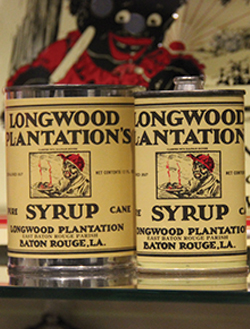 Racism In The KitchenDuring the Jim Crow period a typical American kitchen had many products with images that portrayed blacks in negative ways; these included packaging for cereal, syrup, pancake mix, and detergent; table salt and pepper shakers; cord holders; cookbooks; hand towels; placemats; grocery list reminders; and, wall hangings. Whatever object found in a kitchen could be-and often was-transformed into anti-black propaganda. |  Racism On The LawnThe lawn jockey is a decorative yard ornament that caricatures black people and promotes the idea of their servitude. Typically a cast replica nigh half-calibration, information technology depicts a black man dressed in jockey'south vesture carrying a lantern or a metal ring suitable for hitching a horse. The blackness lawn jockeys often have exaggerated features, such as jutting optics, big cherry lips, a flat nose and curly hair. The mankind of the figure is unremarkably a glossy black color. Traditionally, two styles of lawn jockey have been produced: the stocky, hunched "Jocko" and the taller, thinner "Cavalier Spirit." Both styles were nevertheless manufactured in 2012. Many Americans, specially African Americans, experience that backyard jockeys are racially offensive. It is common for homeowners to repaint the figure'due south skin with pink or white paint to avert charges of being racially insensitive. |
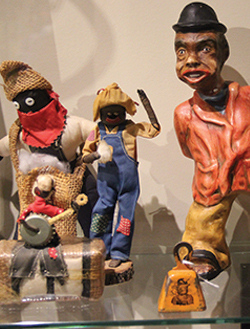 Caricaturing Black PeopleIn the Us, all racial groups have been caricatured, but none as often or in as many ways equally blackness Americans. Blacks have been portrayed in popular culture as pitiable exotics, cannibalistic savages, hypersexual deviants, childlike buffoons, obedient servants, cocky-loathing victims, and menaces to society. These anti-blackness depictions routinely took form in material objects, such equally ashtrays, drinking glasses, banks, games, line-fishing lures, detergent boxes, and other everyday items. This case holds objects that illustrate some of the major anti-black caricatures. Pickaninnies | 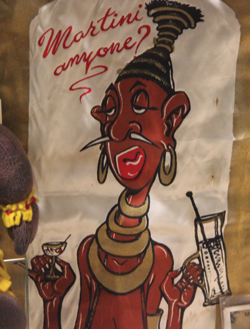 Savage ExtravaganzaThe Savage caricature showed Africans as animalistic, crazed, or comical cannibals, often with bones in their oversized lips. Drawn from the pseudo-scientific early anthropological theories of the late 1800s, the Brutal represented Africans as primitives who were less evolved than their supposedly superior European counterparts. | 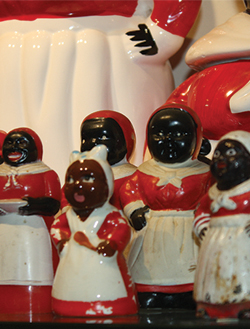 MammyFrom slavery through the Jim Crow catamenia, the mammy extravaganza served the political, social, and economical interests of mainstream white America. During slavery, the mammy extravaganza presented the idea that blacks-in this case, black women-were content, and even happy, every bit slaves. Her wide grin, hearty laugher, and loyal servitude were offered as evidence of the supposed humanity of the institution of slavery. The mammy caricature romanticized the realities of slave and servant life and obscured the unequal foundation of the primary-retainer power structure. Portrayed as an obese, coarse, maternal effigy, the mammy had groovy dearest for her white "family," but often treated her own family with disdain. Although she had children, sometimes many, she was, by mainstream standards, sexually unappealing. She "belonged" to the white family, though it was rarely stated. She was a faithful worker. She had no blackness friends; the white family was her entire world. More information on the Mammy Caricature |
 Racist CartoonsBetween 1928 and 1950, America'due south premier animators-Walt Disney Corporation, Warner Bros., Metro-Goldwyn-Mayer, Merrie Melodies, Looney Tunes, and R.K.O. Radio Pictures-produced many cartoons that ridiculed the appearance, behavior, and intelligence of African Americans and other racial and ethnic minorities. Racist Cartoons | 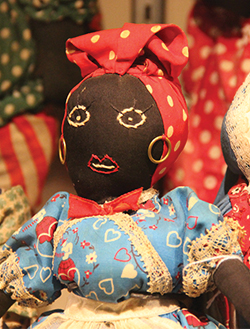 Charbonnet Doll DroveFrom its inception, the Jim Crow Museum had dolls, mostly Mammy, Tom, and Pickaninny versions. In 2010, Marc Charbonnet, a prominent interior designer in New York, donated a drove of dolls to the Museum, including some that defame African Americans and some that exalt them and celebrate African American civilization. | 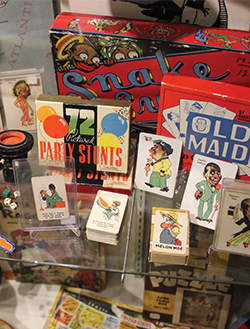 Games And ToysGames are constructive vehicles for spreading racial stereotypes and prejudice. All of the common caricatures of blacks were represented in games. Players, ofttimes children, received letters through a game's graphics and text that blacks were, for instance, lazy or deviant and deserved to exist mocked or hurt. |
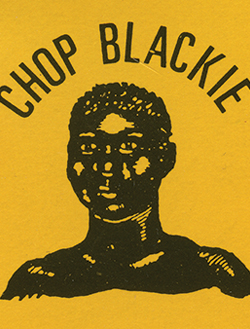 Racist ImportsIn 2011, approximately one-fourth of the objects in the Jim Crow Museum were produced in other countries, including Commonwealth of australia, Brazil, Canada, England, Hong Kong, Japan, Mexico, and Taiwan. |  The N-WordThe give-and-take nigger is a shorthand way of proverb that blacks possessed the moral, intellectual, social, and concrete characteristics of the Coon, Creature, Tom, Mammy, and other racial caricatures. Although considered by many people to be a hateful slur, the word is used in different means and contexts to connote dissimilar meanings. More data on the N-Discussion |  Racism As ArticleAll of the objects in the Jim Crow Museum have market values. In 2011, there were more than 50,000 collectors of "Blackness Americana," a category that includes racist artifacts. By and large, the more racist an object is, the higher the price it commands. |
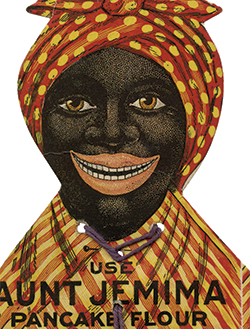 Aunt JemimaIn the 1880s, Chris Rutt, who had recently developed the thought of a self-ascension pancake batter, attended a minstrel show that included a skit with a southern mammy character named Aunt Jemima. Rutt and his partner, Charles Underwood, decided that the mammy, dressed in an apron and bandanna, would assistance distinguish and sell their pancake mix. When the R.T. Davis Factory Company purchased Rutt and Underwood's company, they employed a real person to portray Aunt Jemima in their marketing scheme. Nancy Green, born a slave in Kentucky in 1834, became the first "real" Aunt Jemima. She impersonated Aunt Jemima until her expiry in 1923. At the 1893 Globe's Exposition in Chicago, Greenish, as Aunt Jemima, sang songs, cooked pancakes, and told romanticized stories virtually the Old South as a happy place for blacks and whites. Later, her image was plastered on billboards nationwide, with the caption, "I'se in town, honey." In her role every bit Aunt Jemima, Green made appearances at countless country fairs, flea markets, food shows, and local grocery stores. By the turn of the century, Aunt Jemima, along with the Armour meat chef, were the two commercial symbols most trusted by American housewives. A short video showing the marketing of Aunt Jemima and its touch on on some peoples view of her today. Many consider Aunt Jemima every bit a kind, happy motherly effigy who made great pancakes. Aunt Jemima, sang songs, cooked pancakes, and told romanticized stories about the Old Southward equally a happy place for blacks and whites. But examine how these interpretations came to be and whether they were based on reality or in marketing. How many times does it have to call Aunt Jemima "Happy" before anybody believes information technology? And does just saying she is "Happy" make information technology then? Audio excerpts from the "Aunt Jemima Diversity Show" |
Source: https://www.ferris.edu/HTMLS/news/jimcrow/antiblack/index.htm
Posted by: berryhalseara.blogspot.com


0 Response to "How To Draw Black People Without Being Racist"
Post a Comment